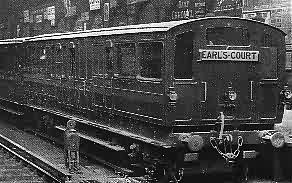
Suburban Electric Railway Association
Located at the COVENTRY ELECTRIC RAILWAY CENTRE, Rowley Road, Baginton, Warwickshire
Established
1996
The History Zone
Electrifying London
The Surface Lines
The surface lines are those that run underground but not in deep level tunnels, being constructed by the 'cut and cover' method, where by the tunnel is dug out from the surface and when deep enough a lid is put back on top at street level to hide the tunnel below.
At the turn of the century two companies were running the surface lines in London - The Metropolitan Railway whose lines ran from Aldgate in the city through tunnels to Baker Street where they emerged into daylight to run onto Harrow, Uxbridge and the main line route to Aylesbury. It also continued its tunnel route round west London from Baker Street to High Street Kensington.The Met also jointly ran a line with the GWR from Paddington to Hammersmith. The other company was the District Railway who ran in tunnels from Mansion House in the City out toward Earls Court in West London from where open air lines took them to Wimbledon, Richmond, Ealing, Hounslow and Hanger Lane. Despite their close proximity in central London the two companies did not get along but on one fact they did agree and that was the need to electrify the tunnel sections of their respective lines.
Despite this common objective there was no co-operation on the system of electrification to adopt. The Met favoured an AC system whilst the District preffered DC. As services by both companies would have to share common tracks a standard system of electrification had to be agreed on and to do this an adjudication committee was set up jointly by both companies. Also both agreed to electrify the three quarter mile long section of line between Earls Court and High Street Kensington with DC current and build an experimental train to try the system out.
The train, six coaches of it, was built by Brown Marshall & Co. and featured four compartment trailers with a driving motor coach at each end. The driver only had control of the leading set of motors when in motion and the rear car was unpowered due to the lack of a control cable running the length of the train. The first test runs were made on the 9th of December 1899 with the first fare paying passengers caried by the experimental service on May the 21st the following year. The experimental train remained in service until the 6th of November 1900 when the project was ended and the coaches returned 50% to each company. Some were absorbed into the steam hauled fleets while the rest were sold on to other railways.

The adjudication committee ruled in favour of a low voltage DC system similar to that of the experiment with a conductor rail and insulated negative return rail which was needed to eliminate earth leakage in the damp tunnel envoiroment.
The District set about a policy of electrifying all their lines, not just those in tunnels - but this project was to be affected by dealings in the District railway boardroom of which details will come later. The Met decided upon electrification for their shortest routes from Aldgate to Earls Court and Hammersmith and Baker Street to Uxbridge. these two aims were achieved in December 1906 and January 1905 respectively. All the surface lines in tunnel were electrified by July 1905 and today these lines form what is known as the Circle Line.
